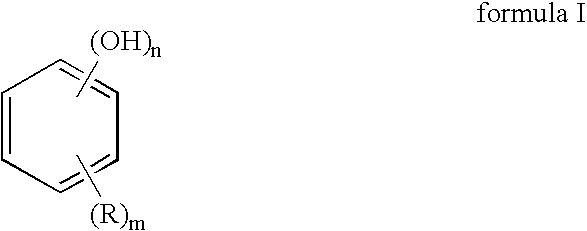Polyphenolics as lubricant oil additives
- Summary
- Abstract
- Description
- Claims
- Application Information
AI Technical Summary
Benefits of technology
Problems solved by technology
Method used
Image
Examples
example 1
One Step Reaction Process
[0092] A four liter glass reaction vessel was sparged with nitrogen and charged with 198 grams (0.47 moles) of a linear C20-28 alkylphenol, 198 grams (0.76 moles) of a branched C12 alkylphenol, 43 grams (0.57 moles) glycine, 6 grams (0.1 moles) acetic acid, 72 grams (0.98 moles) calcium hydroxide, 400 grams of a 100N group II diluent oil, 145 grams of 2-ethylhexanol, 125 grams of ethylene glycol, 38.5 grams (1.23 moles) of paraformaldehyde and 1 drops of foam inhibitor. The reactor was agitated at 800 rpm, and maintained at 14.21 psia under nitrogen. The temperature was ramped to 220° C. in 5 hrs; water removal began just above 100° C.
[0093] Distillation commenced as soon as 220° C. was reached. Initially, vacuum had to be applied very gradually to avoid excessive foaming, and the temperature was allowed to fall to 180° C. Once we were able to hold the reactor at 220° C. and about 1 psia, we held for 0.5 hr, then broke vacuum with nitrogen. The product was...
example 2
Two Step Reaction Process
[0095] A four liter glass reaction vessel was sparged with nitrogen and charged with 395 grams (0.94 moles) of a linear C20-28 alkylphenol, 395 grams (1.51 moles) of a branched C12 alkylphenol, 86 grams (1.14 moles) glycine, 12 grams (0.2 moles) acetic acid, 144 grams (1.95 moles) calcium hydroxide, 800 grams of a 100N group II diluent oil, 120 grams of 2-ethylhexanol, 250 grams of ethylene glycol and 2 drops of foam inhibitor. The reactor was agitated at 800 rpm, and maintained at 14.21 psia under nitrogen. The temperature was ramped to 190° C. in 2.25 hrs; water removal began just above 100° C. The assembly was held at 190° C. for 1 hr.
[0096] After one hour, the heater was lowered, and 170 mls of room temperature 2-ethylhexanol was pumped into the reactor via peristaltic pump. The mixture was cooled to 70° C. so that it could be safely opened and 77 grams (2.45 moles) of paraformaldehyde added. The stopper was replaced, and the reactor was ramped to 220°...
example 3
[0099] A four liter glass reaction vessel was sparged with nitrogen and charged with 395 grams (0.94 moles) of a linear C20-28 alkylphenol, 395 grams (1.51 moles) of a branched C12 alkylphenol, 114 grams (1.52 moles) glycine, 12 grams (0.2 moles) acetic acid, 144 grams (1.95 moles) calcium hydroxide, 800 grams of a 100N group II diluent oil, 120 grams of 2-ethylhexanol, 250 grams of ethylene glycol and 2 drops of foam inhibitor. The reactor was agitated at 800 rpm, and maintained at 14.21 psia under nitrogen. The temperature was ramped to 190° C. in 2.25 hrs; water removal began just above 100° C. The assembly was held at 190° C. for 1 hr.
[0100] After one hour, the heater was lowered, and 170 mls of room temperature 2-ethylhexanol was pumped into the reactor via peristaltic pump. The mixture was cooled to 70° C. so that it could be safely opened and 98 grams (3.10 moles) of paraformaldehyde added. The stopper was replaced, and the reactor was ramped to 220° in 2.5 hrs; note that th...
PUM
| Property | Measurement | Unit |
|---|---|---|
| temperature | aaaaa | aaaaa |
| temperature | aaaaa | aaaaa |
| wt % | aaaaa | aaaaa |
Abstract
Description
Claims
Application Information
 Login to View More
Login to View More - R&D
- Intellectual Property
- Life Sciences
- Materials
- Tech Scout
- Unparalleled Data Quality
- Higher Quality Content
- 60% Fewer Hallucinations
Browse by: Latest US Patents, China's latest patents, Technical Efficacy Thesaurus, Application Domain, Technology Topic, Popular Technical Reports.
© 2025 PatSnap. All rights reserved.Legal|Privacy policy|Modern Slavery Act Transparency Statement|Sitemap|About US| Contact US: help@patsnap.com



